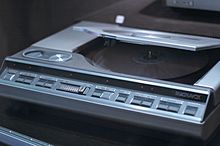Magnavox
This article needs additional citations for verification. (March 2011) |
 | |
| Company type | Subsidiary |
|---|---|
| Industry | Consumer Electronics |
| Founded | 1917 |
Key people | Edwin Pridham Peter L. Jensen |
| Products | Odyssey (Video Game Console) |
| Parent | Philips |
| Website | Magnavox.com |
Magnavox (Latin for "great voice") is a US electronics company founded by Edwin Pridham and Peter L. Jensen, who invented the moving-coil loudspeaker in 1915 at their lab in Napa, California. They formed Magnavox in 1917 in order to market their inventions.[citation needed]
Magnavox is best known for creating the Odyssey, the world's first home video game console. The console started the market for it, which ultimately lead to the 7th Generation consoles we know today.
History
Shortly after its launch, Magnavox became a major consumer electronics and defense company. It manufactured radios, TVs, gramophones, etc. in 1972, Magnavox introduced the Odyssey, which is the world's first home video game console. The introduction of it triggered the beginning of the home video game console market.
In the late 1970s, Philips developed "Laser Disc" technology, producing an optically read, 12 inch disc that would contain recorded video material. In the early 1980s, Philips worked with Sony to invent a standard for optical audio discs (CDs), using the technology developed for the "Laser Disc".
Teamed with Sony, Philips used the Magnavox brand name to introduce Compact Disc standard and equipment for consumer audio with the Magnavox player sold in department stores while the Sony CDP-101 went to high-end audio stores.
Philips later acquired Magnavox's consumer electronics division in 1974, to ensure nationwide distribution for their VLP (later renamed LaserVision) Videodisc technology.
And then, During the late 1970s the company released the Odyssey², also known as the Philips Videopac.
In the early 1980s, Philips merged Sylvania, Philco and Magnavox into one division headquartered in Knoxville, Tennessee, with a manufacturing plant in Greeneville, Tennessee. The Sylvania plant in Batavia, NY was closed and all operations moved to Greeneville. Philips also abandoned the Sylvania trademark which is owned by Osram.
In the late 1990s, some Philips electronics were marketed under the brand name "Philips Magnavox", in an attempt to increase brand awareness of the Philips name in the United States. While it did work to a degree, it also caused confusion to the consumer as to the difference between "Philips Magnavox" products and "Philips" products, resulting in Philips marketing the 2 brands separately again.[citation needed]

The defense group, centered around Fort Wayne, IN, remained independent under the Magnavox Electronic Systems name, first under Philips and later in the Carlyle Group, until it was acquired by Hughes Electronics in 1995.[1] The three areas of business of the MESC operation during the late '80s and early '90s were C-Cubed (Command, Control, and Communication), Electronic Warfare, and Sonobuoys. When Hughes Electronics sold its aerospace and defense operations to Raytheon, the former Magnavox defense operations were transferred as well.[citation needed] Shortly thereafter, Raytheon spun off the sonobuoy operation to form Under Sea Systems Inc, now Ultra-USSI in Columbia City, IN. The remainder of the operations now falls under Raytheon's Network Centric Systems in Fort Wayne, IN.
Among the defense products Magnavox manufactured the AN/ARC-164 UHF radio, AN/SSQ-53 series sonobuoys, AN/ALQ-128 EW equipment, AN/SSQ-62 series sonobuoys, and the Advanced Field Artillery Data System (AFATDS).[2]
The brand also has worked with Funai with their televisions after the Philips Magnavox name was popular.
In Australia, the rights to the Magnavox brand are not owned by Philips but by Mistral Ltd, a Hong Kong trading company that uses it to sell audio/video equipment of a different make. [1]
References
External links
- Articles needing cleanup from July 2010
- Cleanup tagged articles without a reason field from July 2010
- Wikipedia pages needing cleanup from July 2010
- Consumer electronics brands
- Companies established in 1917
- Electronics companies of the United States
- Philips
- Private equity portfolio companies
- Video game companies of the United States
- Companies based in Tennessee
- Companies based in Knoxville, Tennessee
